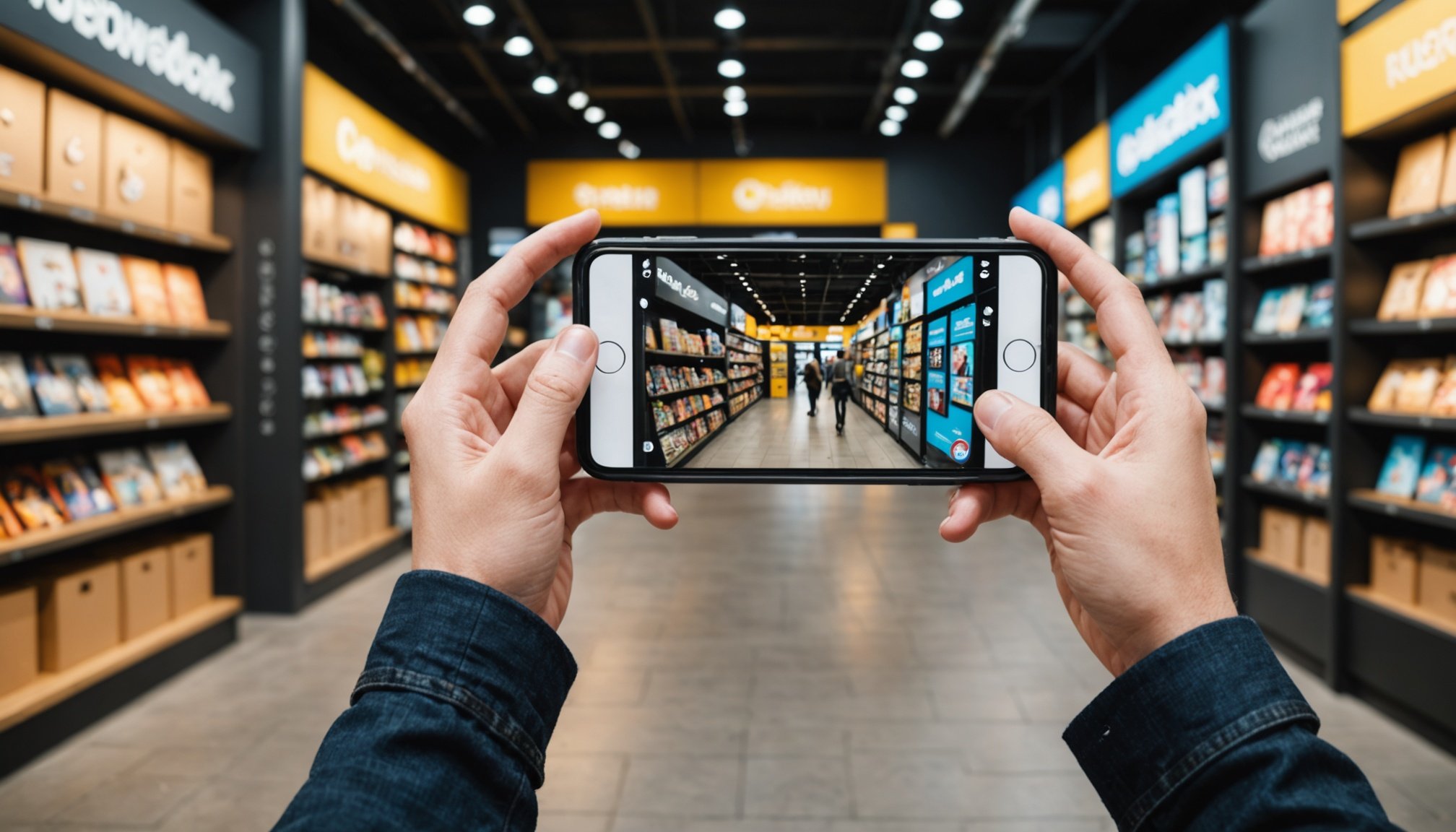Revolutionizing Customer Interaction: Creative Strategies for UK Retailers to Harness Augmented Reality
In the ever-evolving retail landscape, augmented reality (AR) has emerged as a game-changer, transforming how customers interact with products and brands. For UK retailers, integrating AR into their strategies can be a powerful way to enhance customer experiences, boost engagement, and stay ahead in the competitive market.
Understanding Augmented Reality Technology
Before diving into the creative strategies, it’s essential to understand the basics of AR technology. Augmented reality involves overlaying digital information onto the physical world, using devices such as smartphones, tablets, and AR glasses. This technology allows users to view and interact with digital content as if it were part of their immediate surroundings, creating a seamless blend of digital and physical shopping experiences[1].
In the same genre : Essential remote work best practices for uk businesses: your all-inclusive handbook
Successful Case Studies of UK Retailers Implementing AR
Several UK retailers have already made significant strides in incorporating AR into their operations, with impressive results.
Marks & Spencer: Virtual Furniture Placement
Marks & Spencer, a staple in the UK retail market, introduced an AR tool to help customers visualize how furniture would fit in their homes. By offering a virtual placement tool through smartphones, they connected AR with their traditional retail environment, seeing a notable boost in customer engagement and sales[1].
Also read : Building a powerful brand reputation strategy for uk startups in the digital age
Topshop: Virtual Dressing Room
Topshop piloted an AR-based virtual dressing room, allowing shoppers to ‘try on’ clothing without physically changing. This addressed consumer hesitance and offered a practical solution to changing room queues, enhancing the overall shopping experience[1].
Burberry: Elevating Brand Experience with AR
Burberry has been at the forefront of AR innovation in the fashion industry. Their collaboration with Google brought the in-store shopping experience directly to online shoppers’ digital devices. For example, consumers could view 3D images of products like the Black TB bag and Arthur Check Sneaker, enhancing personalized luxury commerce and managing customer expectations about their items[3].
Innovative Tactics for Integrating AR into Retail
Enhancing In-Store Experiences with AR
Retailers can revitalize brick-and-mortar stores by establishing immersive showrooms using AR. These experiences allow customers to interact with products in dynamic ways, encouraging interest and prolonged visits. Imagine customers strolling through aisles with their smartphones, accessing detailed product information or experiencing a virtual vintage décor overlay in a furniture store[1].
AR-Driven Product Visualization Techniques
Enabling customers to visualize products in real-world settings is a game-changer. Here are some key tactics:
- Virtual Try-On Solutions: For clothing, beauty products, or even furniture, virtual try-on solutions provide confidence in purchases, significantly reducing return rates. This interaction transforms the decision-making process, making it more informed and satisfying[1][3][4].
- Interactive Product Demos: AR can be used to create interactive product demos, allowing customers to see how products work in real-time. For instance, a customer can use AR to see how a piece of furniture would look in their living room or how a cosmetic product would appear on their face[1][2][4].
Potential Impact of AR on Consumer Behavior
The integration of AR into retail is reshaping consumer behavior and the overall shopping experience.
Reducing Purchase Uncertainty
AR allows customers to preview products before making a purchase, significantly reducing uncertainty. By visualizing how furniture fits in their home or how clothing looks on their body, customers make more informed decisions, leading to increased trust and loyalty[1][3][5].
Fostering Customer Loyalty
Personalized AR experiences create memorable brand interactions, positioning retailers as innovative leaders. Enhanced engagement leads to a deeper connection with the brand, increasing the likelihood of repeat purchases. Here are some ways AR fosters loyalty:
- Personalization and Customization: AR technology can offer tailored recommendations and suggestions based on customer preferences and previous purchases, building a stronger emotional bond between the customer and the brand[3].
- Gamification and Rewards: Retailers can incorporate gamification elements into AR experiences, such as virtual scavenger hunts or digital rewards, encouraging repeat visits and engagement[3].
- Social Sharing and Word-of-Mouth Promotion: AR experiences can be visually impressive and shareable on social media, generating word-of-mouth promotion and attracting new customers while solidifying the loyalty of existing ones[3].
Future Predictions for AR in UK Retail
As AR technology becomes more prevalent, several trends and challenges are on the horizon.
Integration with Emerging Technologies
Future trends point towards more sophisticated implementations of AR, particularly with the integration of artificial intelligence (AI) and machine learning. These technologies will offer personalized experiences that cater to individual consumer preferences, enhancing the shopping experience further[1].
Technical Hurdles and Opportunities
While technical hurdles such as ensuring cross-platform compatibility and maintaining up-to-date software remain, the growing consumer demand for immersive shopping experiences offers substantial business growth prospects. Forward-thinking retailers can leverage these opportunities to gain competitive advantages in the tech-driven market.
Practical Insights and Actionable Advice
For UK retailers looking to harness the power of AR, here are some practical insights and actionable advice:
Start Small and Scale Up
Begin with simple AR applications such as virtual try-on solutions or interactive product demos. As you gather data and customer feedback, you can scale up to more complex implementations like immersive showrooms.
Invest in Data Analytics
Use data analytics to understand how customers are interacting with your AR experiences. This data can provide valuable insights into customer preferences and behaviors, helping you refine your AR strategies.
Ensure Cross-Platform Compatibility
Make sure your AR experiences are compatible across various devices and platforms. This ensures that all customers can access and enjoy the AR features, regardless of their device.
Engage with Customers in Real Time
Use AR to provide real-time interactions with your team. For example, customers can use AR to get product information and have real-time interactions with your representatives on video chat or in real life[2].
Table: Benefits of AR in Retail
| Benefit | Description | Examples |
|---|---|---|
| Enhanced Customer Experience | Provides an immersive and interactive shopping experience. | Marks & Spencer’s virtual furniture placement, Topshop’s virtual dressing room[1]. |
| Reduced Returns | Allows customers to visualize products in their own environment, reducing purchase uncertainty. | Burberry’s 3D product views, Tiffany & Co.’s AR jewelry visualization[3][4]. |
| Increased Engagement | Encourages customers to spend more time interacting with products. | Interactive product demos, gamification elements[1][3]. |
| Improved Customer Satisfaction | Enhances decision-making by providing a more realistic view of products. | Virtual try-on solutions, AR-powered fitting rooms[3][4]. |
| Personalization | Offers tailored recommendations and suggestions based on customer preferences. | AR-driven personalization, AI-integrated AR experiences[1][3]. |
| Social Sharing | Encourages customers to share their AR experiences on social media. | Shareable AR experiences, word-of-mouth promotion[3]. |
Quotes from Industry Experts
- “Augmented reality is setting a benchmark in the retail sector, and several UK retailers are leading this innovation. By integrating AR into their operations, these businesses have significantly enhanced the shopping experience, leading to increased customer engagement and sales.” – Nitech Consulting[1].
- “71% of shoppers say that they would likely shop more frequently when using AR-powered apps. This highlights the potential of AR to drive sales and achieve business objectives in the retail sector.” – Deloitte Report[3].
- “The integration of AR into retail is reshaping consumer behavior and the overall shopping experience. By allowing customers to preview products before making a purchase, AR significantly reduces uncertainty and enhances purchase confidence.” – Netguru[3].
Augmented reality is not just a trend; it is a transformative force in the retail industry. By understanding the technology, learning from successful case studies, and implementing innovative tactics, UK retailers can revolutionize customer interactions. As the future of retail continues to evolve with emerging technologies like AI and machine learning, those who embrace AR will be well-positioned to capture the hearts and wallets of their customers.
In the words of a retail expert, “The key to successful AR integration is to create experiences that are both immersive and practical. By doing so, retailers can enhance customer satisfaction, foster loyalty, and ultimately drive business growth in a highly competitive market.” As you embark on this journey, remember that the future of retail is not just about technology; it’s about creating meaningful, engaging experiences for your customers.

